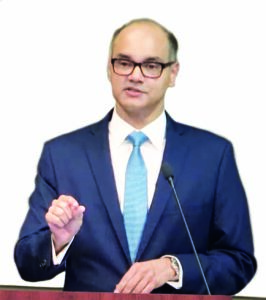
Imagine a world in which the enduring Dacron graft, birthed by vascular pioneer Michael DeBakey, MD, some 70 years ago as an open repair for aortic aneurysms, could be performed minimally invasively with the sorts of gains associated with endovascular aneurysm repair (EVAR). A procedure with an extremely magnified view, that affords full control of instruments and blood vessels, and in which the execution of the anastomosis is essentially an extension of the surgeon’s hands inside the abdomen.
That is the pitch from Charudatta Bavare, MD, a vascular surgeon at the Debakey Heart and Vascular Center at Houston Methodist Hospital in Houston, Texas, to his fellow vascular surgeons who remain to be convinced that robotic surgery is a key part of vascular surgery’s future.
Bavare is at the vanguard of efforts—led by his boss, Alan Lumsden, MD, the Walter W. Fondren III Presidential Distinguished Chair at DeBakey Heart & Vascular Center—to build out a vascular robotics program.
To be sure, the Houston team have been busy banging the drum for robotic surgery in vascular of late. At the Society for Clinical Vascular Surgery (SCVS) Annual Symposium in Scottsdale, Arizona, in March, Bavare presented a case of iatrogenic injury of the external iliac artery repaired via robotic-assisted laparoscopic surgery. SCVS 2024 also heard from Petr Stadler, MD, from Na Homolce Hospital in Prague, the Czech Republic, during a forum hosted by Lumsden. Stadler possesses one of the foremost experiences across the globe of using a robotic platform in vascular surgery. Finally, in late March, Houston Methodist hosted its first Robotic Surgery Summit.
Yet, the trouble is, explains Bavare in an interview with Vascular Specialist, vascular surgery in the U.S. is caught in a sort of catch-22. Because there are no certified trainers in the vascular surgery ranks on the robotic platform, an otherwise burgeoning cadre of general surgery-trained vascular fellowship graduates—whose residency included training in robotic surgery—are at a standstill. As things stand, they won’t be able to perform robotic vascular surgical procedures.
But then there is Bavare himself. The Indian-born, U.S.- trained vascular surgeon took that very general surgery-vascular fellowship route into the specialty. Those laparoscopic skills, fine-tuned during a stint post-fellowship at a rural Texas hospital where he performed both general and vascular surgery, helped lead to the moment when Bavare returned to Houston Methodist and, soon afterward, Lumsden started to entertain thoughts vascular surgery could be left behind if it did not buy into robotic-assisted surgery. With encouragement from Lumsden, Bavare embarked on a laborious journey to acquire the certification and credentialing required to be able to perform vascular procedures using a robotic platform. Now, following in the pioneering footsteps of its namesake, the DeBakey Heart and Vascular Center boasts the first-of-its-kind robotic vascular surgery program in the U.S. And Bavare is quickly racking up experience.
“As of today, I have done 49 robotic cases over the past two years,” he says. “A little less than half have been peritoneal dialysis catheter cases, many release of the median arcuate ligament, two splenic artery aneurysms, one renal vein transposition, and recently our first aortobifemoral bypass.
“For the last 10 years, there was no interest in the robot. For the last two years, there has been an incredibly high interest, especially from trainees in general surgery, just like me. Fifteen years ago, I had no exposure, but today every single vascular fellowship candidate who has finished a general surgery residency is fully certified on the robot and fully capable of doing robotic procedures.”
Back on the Dacron graft, Bavare has one more message: “If we can translate the most durable Dacron repair into a minimally invasive approach, that would give the patient the benefit of both [the open and EVAR] worlds.










